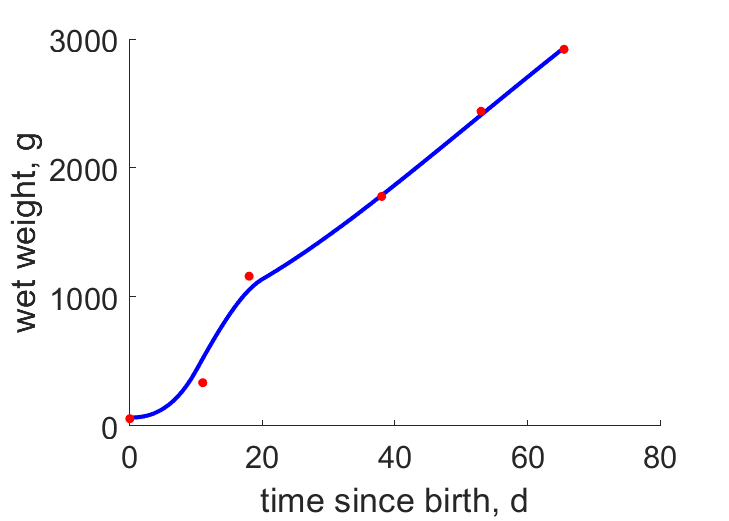Predictions & Data for this entry
| Model: std | climate: A, Cwa | migrate: Ms | phylum: |
| COMPLETE = 2.8 | ecozone: TPi | food: biCvf | class: |
| MRE = 0.051 | habitat: 0iTf | gender: Dg | order: |
| SMSE = 0.005 | embryo: Tnpfm | reprod: O | family: |
Zero-variate data
| Data | Observed | Predicted | (RE) | Unit | Description | Reference |
|---|---|---|---|---|---|---|
| ab | 30 | 27.32 | (0.08945) | d | age at birth | Urfi2011 |
| tx | 65 | 65.35 | (0.005349) | d | time since birth at fledging | Urfi2011 |
| tp | 195 | 219.2 | (0.1241) | d | time since birth at puberty | guess |
| tR | 1460 | 1460 | ( 0) | d | time since birth at 1st brood | guess |
| am | 1.044e+04 | 1.033e+04 | (0.01028) | d | life span | AnAge |
| Ww0 | 89 | 81.76 | (0.08132) | g | initial wet weight | avibase |
| Wwb | 55 | 64.66 | (0.1756) | g | wet weight at birth | Urfi2011 |
| Wwi | 2500 | 2478 | (0.008874) | g | ultimate wet weight for females | avibase |
| Wwim | 3190 | 3183 | (0.00208) | g | ultimate wet weight of males | avibase |
| Ri | 0.005479 | 0.005647 | (0.0306) | #/d | maximum reprod rate | avibase |
Uni- and bivariate data
| Data | Figure | Independent variable | Dependent variable | (RE) | Reference |
|---|---|---|---|---|---|
| tW |  | time since birth | wet weight | (0.04047) | Urfi2011 |
Pseudo-data at Tref = 20°C
| Data | Generalised animal | Mycteria leucocephala | Unit | Description |
|---|---|---|---|---|
| v | 0.02 | 0.03216 | cm/d | energy conductance |
| p_M | 18 | 1117 | J/d.cm^3 | vol-spec som maint |
| k_J | 0.002 | 0.04612 | 1/d | maturity maint rate coefficient |
| k | 0.3 | 0.3025 | - | maintenance ratio |
| kap | 0.8 | 0.9272 | - | allocation fraction to soma |
| kap_G | 0.8 | 0.7998 | - | growth efficiency |
| kap_R | 0.95 | 0.95 | - | reproduction efficiency |
Discussion
- Body temperatures are guessed
- scaled functional response varies
- males are assumed to differ from females by {p_Am} only
- tW data is inconsistent with tJX data after day 30; additional food intake must have occured
- mod_1: Pseudo-data point k is used, rather than k_J; Data set tp and parameter t_R are added, the latter replacing clutch interval t_N. Postnatal T is based on PrinPres1991, see get_T_Aves. See further the revision page, theme puberty
Bibliography